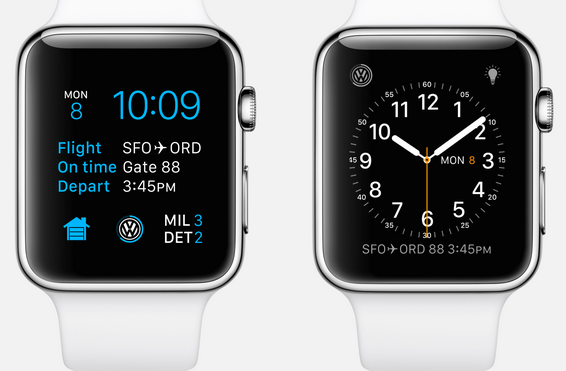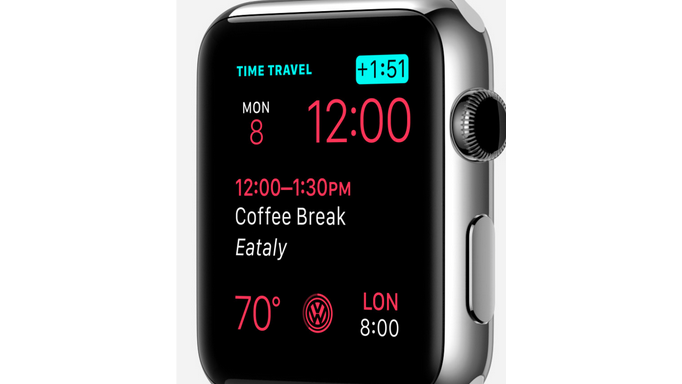The dust has now settled from Apple’s Worldwide Developers Conference (WWDC) held in San Francisco earlier this month, and we finally know what to expect in the next iteration of the Apple Watch operating system, dubbed watchOS 2.
Less than two months after consumers started getting their hands on the Watch, Apple announced some major feature improvements to the wrist device. Happily it seems we were pretty much spot-on with what we predicted in our Wish List for Apple Watch 2.0.
Let’s go through our wish list point-by-point and see which items Apple has fulfilled, as well as potential use cases for the newly-announced features.
1. Native Apps
The announcement regarding native apps didn’t really come as a surprise as Tim Cook had mentioned last year that this improvement would be coming. Nonetheless, this was our number one wish, and so we are thrilled that apps will be able to run natively on the Watch as part of the iOS 9 update.
As we mentioned in our previous post, a notable issue is that a lot of the early Watch apps take forever to launch.
In the current version, Watch apps primarily consist of static UI control elements, with the run-time logic and code being forced to run on the paired iPhone. With watchOS 2, we will see native apps that run entirely on the Watch itself, providing quicker response times.
More impressively, with the ability to run code solely on the Watch, the wrist device is now able to synchronize data from the Internet (instead of relying on the iPhone) to update the app UI.
Potential Use Case
Let’s take a look at the MLB.com At Bat app. Smarter logic combined with the ability to run apps natively means users can access the app and dynamic data (baseball scores in this case) almost instantaneously.
And if you happen to access the app later on the iPhone, you won’t have to re-download the data from the Internet to the phone. Instead, you will sync it from the Watch to the iPhone. (And this will work both ways.)
2. Direct Access to the Watch Sensors
Another big limitation of watchOS 1 was the inability of developers to access sensory information like heart-rate.
Given that a lot of Watch users are health enthusiasts — after all, the device is specifically marketed to them — this seemed like something that would be quite important. Yet, with the first version of the operating system, developers were only able to access health data indirectly through HealthKit on the iPhone, which does not operate in real-time.
Thankfully, this will no longer be the case. With watchOS 2, Apple announced that developers will indeed have access to the heart-rate sensor.
This is certainly another win for developers, and something we weren’t 100% sure we would see with the first version of the device, due to battery concerns.
Potential Use Case
This will make real-time health tracking a possibility for third-party vendors like RunKeeper, who will now be able to constantly poll to track the heart sensors of runners and joggers.
(For more on RunKeeper and other health and fitness apps, check out our post on The Future of Health Apps on Apple Watch.)
3. Direct Access to the Digital Crown, Microphone, and Custom Gestures
On this point, we got most of our wish list fulfilled: we aren’t getting any new gestures, but we are getting access to the digital crown, as well as the accelerometer and microphone.
Digital Crown
As we mentioned previously, the digital crown is a fantastic digital take on a timeless instrument seen in mechanical watches. In the current version, Apple uses it for various operating system features, such as enabling zooming and scrolling.
Now, with watchOS 2, developers will be able to fully customize the digital crown.

Potential Use Case
Tapping into the digital crown could see apps that allow for app state changes more rapidly and intuitively. For example, an app could have a rating scale or list of settings that the user can scroll through expeditiously.
Accelerometer
Access to the hardware accelerometer will also deliver new classes of apps and functionality to users.
Potential Use Case
The accelerometer presents new opportunities for sports and physical activity apps. For example, a golfing or baseball app could provide a Watch version that is capable of detecting the swing of the club or bat and provide a visual indicator showing the swing tempo.
Taptic Feedback
With watchOS 2, developers will also have access to taptic feedback, which will allow them to send specific vibrating feedback types to users, with a consistent set of vibration modes to allow for a consistent response depending on whether the response is an error or alert, for instance.
Right now, Apple has a list of 7-8 types of taptic feedback patterns. By providing familiar patterns for certain situations, Watch users will be able to develop a premonition of the alert message context.

Potential Use Case
In the way that Apple uses distinct taptic feedback patterns in Maps directions for turning left versus right, a similar use case can be made for other apps.
A messaging app, for example, could provide one type of vibrating alert for a personalized message, a more subtle alert for emoji messages or group messages, and another distinct taptic pattern when an image is being transmitted.
Microphone
Moving on to the microphone, this was another feature we were hoping would be opened up to developers, and Apple is delivering.
Previously, only Apple and a handful of third-party developers had access to the microphone, including WeChat, Evernote, and Shazam. With watchOS 2, we will be able to use the microphone directly to record audio from the Watch and have access to the audio within the Watch app.
Potential Use Case
We may start seeing a new wave of apps that allow for more meaningful two-way communication.
Given the Watch’s lack of keyboard, chat apps must either rely on a set of templated pre-defined responses or emojis. Although we haven’t seen Siri opened up yet, the ability to record audio provides potential for iOS apps to receive the audio file and either send the audio raw or convert the content into digital “dictation.”
A note-taking app could provide digital audio dictation or a new messaging app could send an audio message to another app.
4. More UI Controls
In the initial release for Xcode 6, we were only given a limited number of UI elements we could use, without the ability to create custom ones.
With watchOS 2, we still don’t have the ability to create custom ones, but Apple has delivered new UI controllers to make our Watch apps richer.
Drop-Down Picker
One of those is a new drop-down element, which allows you to use the digital crown to scroll through a list of elements, akin to the UIPicker in iOS. This is something we have seen before when configuring our watch face and scrolling between the various complications.
The drop-down picker allows for an in-place browsing of various options, like selecting your birth year, and is useful when there are more than four choices. A visual progress indicator and use of the digital crown allows users to scroll through the options speedily, without getting lost.
Videos
We are also getting the ability to play videos within the Watch. This is suitable for video content that is short, like the videos we see on Vine. Apple has stressed that it is not ideal to show videos longer than a few seconds because there is a significant battery hit.
Potential Use Case
This feature would best be suited to apps that provide 3-10 second short clips, such as a social media app, allowing Watch users to enjoy quick snippets of visual content. Any more than 10 seconds would best be handed-off to the iPhone.
Alerts and Action Sheets
Finally, we are receiving new alerts and action sheets, similar to iOS, which provide a standard interface to present messages to users modally.
The alert sheet would contain a brief message, as well as a title and one or two buttons, and is ideally used when you need your user to confirm something prior to continuing.
5. Third-Party Complications and Watch Faces
Complications
We aren’t quite getting new watch faces, but we are getting the ability to create custom complications. These are the little widgets we see in many of the existing watch faces.
Complicates are tiny pieces of data, like little tickers, that provide contextual information to the user without them having to leave their watch face and navigate to the associative app.
By selecting the complication, it will launch the full Watch app for further information. We have seen these with Calendar events and world time.
With ClockKit and watchOS 2, developers will now be able to create their own complications.
Potential Use Case
An app like MLB.com At Bat could present a personalized complication showing the user’s favorite baseball team, along with the latest game results or live-ticker score. The benefit of having it as a Watch complication means the user can just quickly look down at his or her watch face, without having to go to a separate glance or drill down to the app.
Time Travel
A new feature that developers will be able to tap into is what Apple has dubbed Time Travel.
While this doesn’t involve any real-life travel to a different time, it does allow users to scroll into the future or past through the use of the digital crown.
Potential Use Case
With Time Travel, app developers will be able to add the feature of using the device’s digital crown to go forwards or backwards in time.
For example, in a Calendar complication widget, a user is able to go backwards to see a past event or scroll into future events. In the case of the baseball app, they would be able to scroll backwards or forwards between games or even innings.
In Summary
With the launch of the Apple Watch and watchOS 1, it was clear that the device had some serious shortcomings, despite the beautiful hardware, which prompted us to come up with our Wish List for Apple Watch 2.0.
Thankfully, less than two months after the first batch of Watches started shipping out, WWDC took place with Apple announcing some significant feature improvements to the operating system when iOS 9 is released later in the fall.
The shortcomings identified on our list included a lack of direct access to hardware sensors and features on the Watch (such as the heart-rate sensor and microphone), watch face complications, and lagging performance.
The timing of the product introduction and operating system refresh mean we won’t have to wait long to get the promised improvements. In this sense, Apple has exceeded our expectations, providing substantive updates without the need for a new device.
Of course, there are more improvements that can (and almost certainly will) be made. But due to Apple’s NDA, we will have to remain tight-lipped for a little longer.
One thing is for sure though, with watchOS 2, the Apple Watch will begin transitioning from a niche geek device to a more mainstream accessory.
Your app could be perfect for the Apple Watch and we’d love to help you build it. Try out the ThinkApps for Watch tool to brainstorm and explore your app ideas. Or, if you already have a specific idea in mind and just need some help with development, reach out to our Apple Watch team. We can help you get started today.






